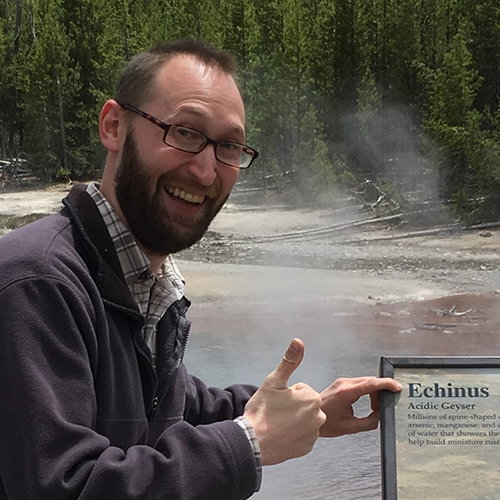Dr. James Thomka
Assistant Professor of Geology
My research falls within the broad fields of paleontology and stratigraphy, with an emphasis on deep-time interactions between organisms and their physical environment. This encompasses studies into the biology, ecology, and preservation of fossil organisms and communities (as well as modern counterparts where appropriate); studies of trace fossils and sedimentary characteristics of the units containing fossil assemblages; and studies of the stratigraphic relationships between relevant intervals of the geologic record. Results from these analyses form the framework for interpretation of broader linkages between the biosphere and climatic-oceanographic-tectonic systems.
I have engaged in research into nearly all forms of ancient life, including microorganisms, plants, trace fossils, macroinvertebrates, and vertebrates. My students and I have been particularly active in pursuing the following research areas:
- Preservation of fossil echinoderms, including applications of crinoid taphonomy, ‘cystoid’ taphonomy, and echinoid taphonomy to paleoenvironmental reconstruction and facies analysis. Conditions responsible for exceptional preservation of echinoderm assemblages have also been heavily investigated.
- Parasite-host and predator-prey dynamics in the fossil record, focusing on the patterns of host-specificity among pit-forming parasites on stalked echinoderms, frequencies of skeletal regeneration of echinoderms following predatory attacks, and evolutionary changes induced by such interactions.
- Ecology and preservation of organisms encrusting hard substrates, with an emphasis on interpreting the functional morphology and sedimentological significance of attachment structures. Sea-level controls on the development of biological buildups (reefs, bioherms, biostromes, etc.) are a related area of study.
- Patterns of marine authigenesis, particularly the stratigraphical, geochemical, and preservational importance of concretions, hardground surfaces, and indicators of early diagenetic mineralization. Siderite (FeCO3) concretions, including examples containing spectacularly preserved fossil material, are a frequent subject of study.
- Trace fossils (ichnofossils) as sources of information in sedimentology, stratigraphy, and paleoecology. Research has focused on using information derived from trace fossils to improve interpretations of depositional environments, relative sea-level changes, and biotic interactions.
- Global climatic/oceanic instability and associated biological turnover during the Late Ordovician through middle Silurian. This includes integration of sequence stratigraphic, stable isotopic, magnetic susceptibility, and paleontological datasets.
I make a concerted effort to include students in my research, and remain active in supervising undergraduates who are interested in paleontology and sedimentary geology both as independent studies and as part of Honors College theses. I encourage you to contact me if you would like to hear more about opportunities to advance science through original research!
- Education
-
Ph.D., 2015, University of Cincinnati (Cincinnati, Ohio)
Dissertation: Dynamic Linkages Between Stratigraphy, Climate, Oceanography, and Biotic Events in the Middle Silurian of Eastern Laurentia
-
M.S., 2010, Auburn University (Auburn, Alabama)
Thesis: Genesis and Taphonomy of a Crinoid Lagerstätte in the Upper Pennsylvanian Barnsdall Formation of Northeastern Oklahoma
-
B.S., 2008, University of Tennessee—Martin (Martin, Tennessee)
Thesis 1: Siderite Concretions of the Upper Cliff Coal Interval (Pennsylvanian: Westphalian A): Fossil Content and Paleoenvironmental Implications
Thesis 2: Diagenesis and Morphology of Unusual Stromatolites in the Upper Cambrian Copper Ridge Dolomite, Cherokee Lake, East Tennessee
-
- Teaching Areas
- Research Areas
- Recent Publications
